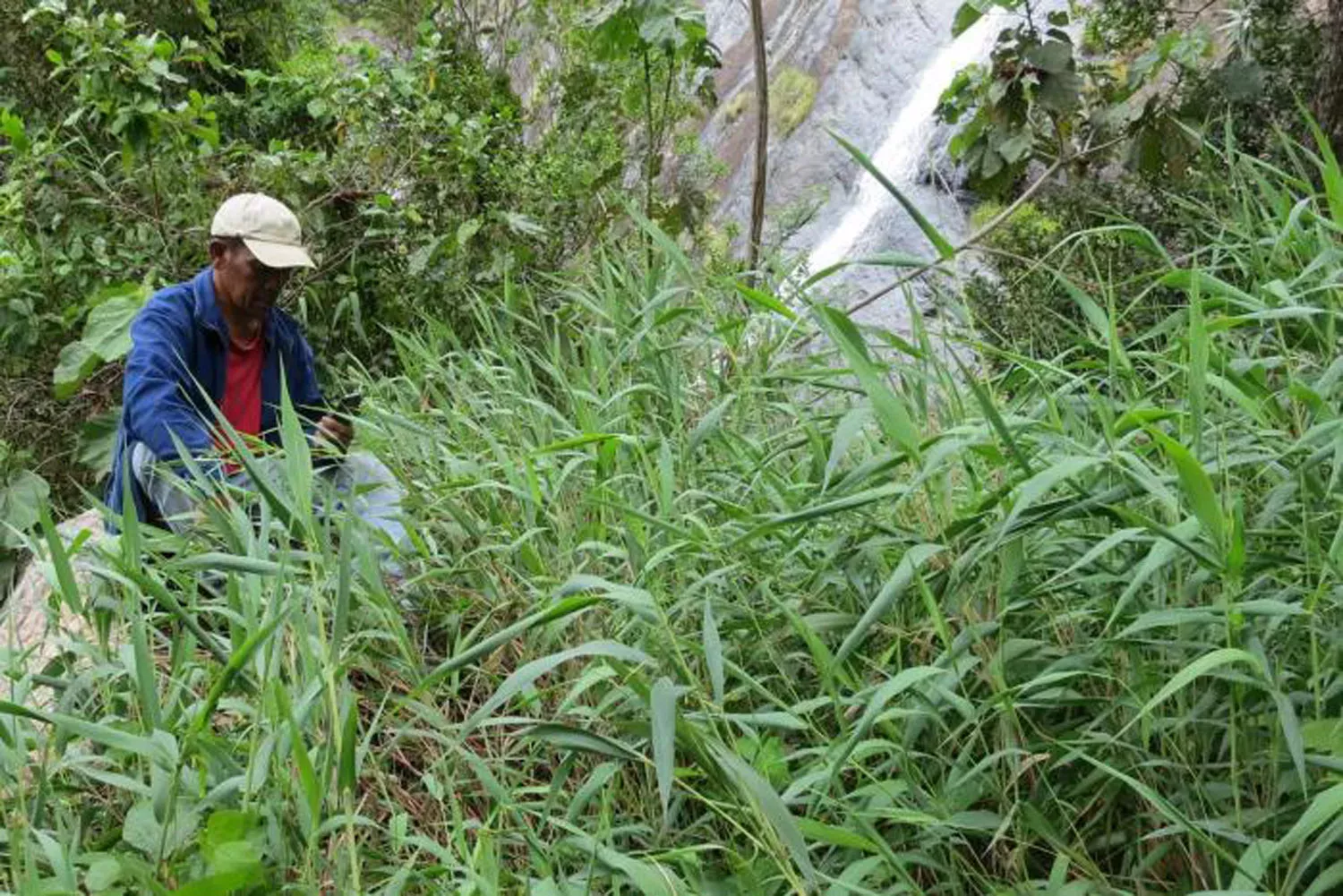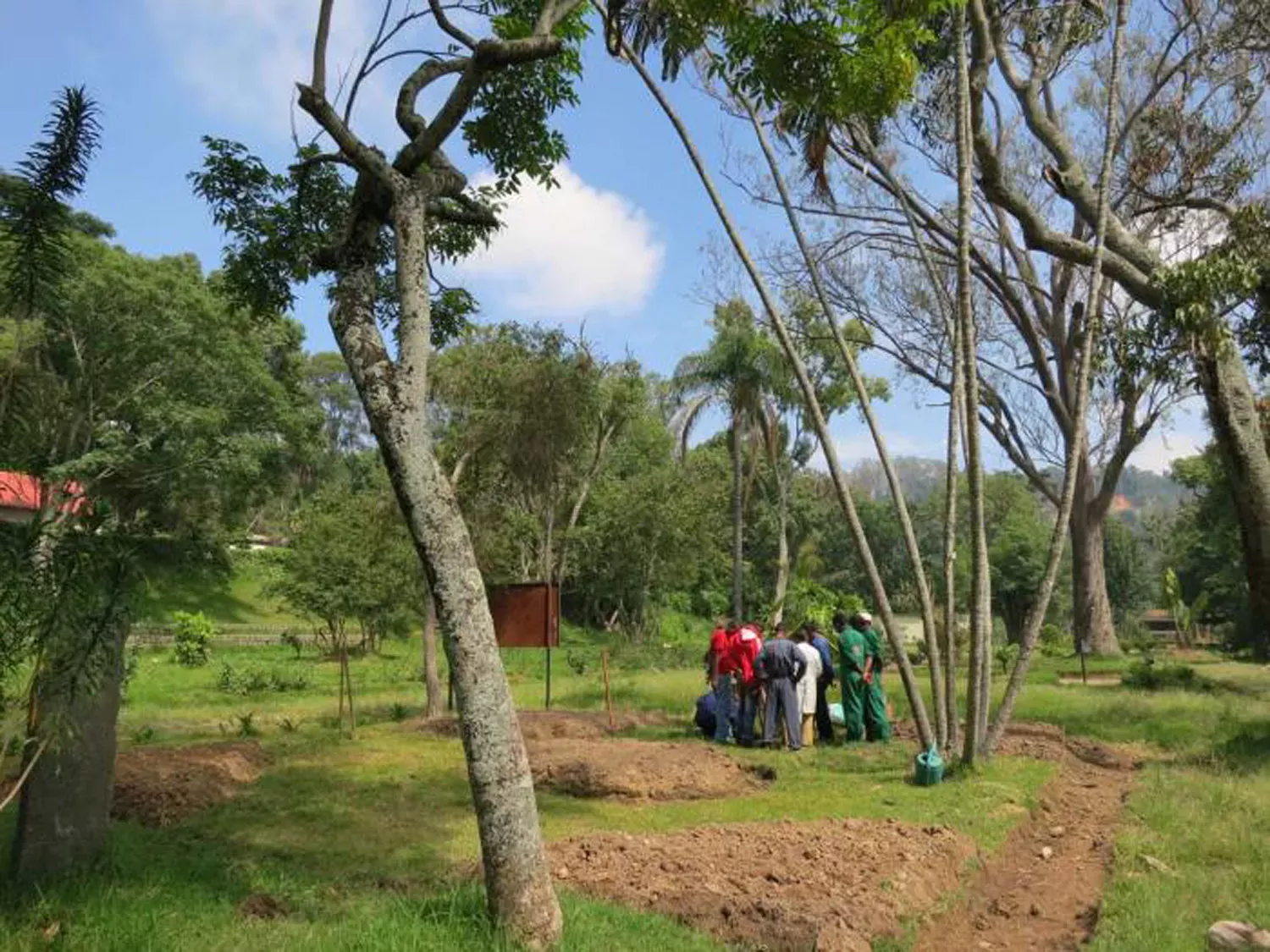Ancient Madagascan grass sheds light on crop evolution
Bat Vorontsova, Kew's grass taxonomist, describes how an ancient grass lineage from Madagascar could provide valuable insights into today's crop species.

Sugarcane and maize are humanity’s most productive crops in total weight produced globally per year (FAO 2014). What makes these two species more useful and more successful than others? The early evolutionary history of the grass family (Poaceae) is poorly understood because of insufficient information preserved in the DNA sequences, and because many ancient grass lineages are thought to have become extinct. Understanding this history could help us improve crops and develop new crops, to address food security and to adapt to climate change.
Grasses are the most thoroughly studied family of flowering plants. However, our knowledge of the species in Madagascar is still poor. Lecomtella madagascariensis, an endemic Madagascan grass, was recently collected and sequenced for the first time using Next Generation Sequencing, where DNA is broken into tiny fragments and specialist algorithms are used to reassemble the sequences of those fragments. When the full chloroplast sequence of Lecomtella madagascariensis was reassembled it proved to be unlike any other grass chloroplast sequenced to date. Analysis of the chloroplast together with the nuclear regions phyB, ppc-aL1, and ppc-aR suggests that Lecomtella represents an ancient lineage that diverged from the ancestors of sugar and maize around 20 million years ago (Besnard et al. 2013).
Many grass lineages in dry and arid areas have a C4 photosynthetic system: a set of anatomical, physiological, and biochemical adaptations to fix carbon dioxide more efficiently than the standard C3 photosynthetic system. C4 has evolved at least 22 times in the grass family (e.g. Christin et al. 2013). Sugarcane and maize are both C4 species, which allows them to be more productive when it is hot and dry. Lecomtella madagascariensis is a C3 species and comparing its unique DNA with that of the C4 crops therefore provides an opportunity for valuable insights into how C4 evolves and how the photosynthetic efficiency of C3 plants could be improved.

Lecomtella madagascariensis has unusual morphology as well as unusual DNA. It is the only species in its genus and tribe, and it occurs on a single mountain range in southern Madagascar, near streams on granite outcrops of the Andringitra Mountains. Lecomtella spreads by long underground rhizomes and forms dense patches of vegetative growth with blue-green leaves. Its local name is fatakamanga, meaning 'blue bamboo'.
For many years scientists and park rangers in the Andringitra National Park could not identify this plant because it only flowers occasionally, and when flowering does occur the majority of the spikelets are male. The rare hermaphrodite florets are subtended by unusual fleshy appendages, but seed dispersal has never been observed and the mechanism of seed dispersal is not known.
This traditional line drawing plate of Lecomtella madagascariensis by Lucy T. Smith was awarded second prize at the Margaret Flockton Awards for botanical art in 2012. In spite of modern digital imaging technologies dissections and drawings like these remain the most efficient way of presenting the scientifically important aspects of plant morphology on a single page. (Drawing: Lucy T. Smith).
The analysis of Lecomtella is part of an ongoing Kew project on the grasses of Madagascar, with the aim of providing an inventory of the species and their distributions. The only published treatment of Malagasy Poaceae (Bosser 1969) includes just half of the estimated 600 species found on the island. The species not included are impossible to identify in Madagascar as there are no identification keys and the only comprehensive herbarium collection is held at the Muséum National d'Histoire Naturelle in Paris, with the virtual herbarium (Sonnerat 2014) unfortunately not accessible from Madagascar due to poor internet speed.

A significant number of species have not been described at all, and recent collections indicate the presence of at least one undescribed genus. Our task at Kew therefore involves describing new species, producing taxonomic revisions of groups with the greatest numbers of endemic species, and developing methodology to define grassland communities and research their history.
Lecomtella madagascariensis is one of the species now cultivated in the new Grass Garden at the Parc Botanique et Zoologique de Tsimbazaza in Antananarivo, designed by Michelle Cleave from RBG Kew and supported by the Royal Horticultural Society. Bringing rare species into cultivation and creating inspiring gardens increases our knowledge and helps contribute to the body of scientific research data on economically important plant groups.
The origin of grasslands in Madagascar is an area of debate (Bond et al. 2008; Willis et al. 2008) and completing the taxonomic delimitation of the grasses will provide a platform for an improved understanding of landscape history. Revision of the genus Andropogon (Vorontsova et al. 2013) and work on Aristida (Vorontsova 2013) has already demonstrated the presence of numerous endemic open habitat species with a C4 photosynthetic system that are restricted to the central highlands, areas previously thought to be deforested within the last two thousand years.
Building our knowledge of rare grasses builds our understanding of grass evolution. Our discovery that the Lecomtella lineage is likely to have played a part in the evolution of panicoid grasses, giving rise to maize and sugarcane, has opened up new avenues of research and has many potential applications. Improving our understanding of grass evolution helps us understand how productive crops evolved and this information can then be used to improve crop breeding. As food security becomes a global issue it will be more important than ever for crop breeding to be informed and underpinned by evolutionary science. Understudied ancient and isolated tropical species are therefore far more important than they seem.
This work is part of Bat Vorontsova’s ongoing project on the grasses of Madagascar, collaborating with the Kew Madagascar Conservation Centre and with Guillaume Besnard at CNRS-Toulouse.
References
- Besnard, G., Christin, P. A., Malé, P. J. G., Coissac, E., Ralimanana, H., & Vorontsova, M. S. (2013). Phylogenomics and taxonomy of Lecomtelleae (Poaceae), an isolated panicoid lineage from Madagascar. Annals of Botany 112: 1057–1066.
- Bond, W. J., Silander, J. A., Ranaivonasy, J. & Ratsirarson, J. (2008). The antiquity of Madagascar's grasslands and the rise of C4 grassy biomes. Journal of Biogeography 35: 1743-1758. doi: 10.1111/j.1365-2699.2008.01923.x.
- Bosser, J. (1969). Graminées des pâturages et des cultures à Madagascar. Mémoire ORSTOM 35: 1-440.
- Christin PA, Osborne CP, Chatelet DS, et al. (2013). Anatomical enablers and the evolution of C4 photosynthesis in grasses. Proceedings of the National Academy of Sciences, USA 110: 1381–1386.
- FAO (2014). Food and Agriculture Organisation of the United Nations. Available online
- Kellogg EA (in press) Poaceae. In: The Families and Genera of Vascular Plants, ed. K. Kubitzki.
- Sonnerat (2014). Spécimens d'herbier - Formulaire de recherché. Muséum National d'Histoire Naturelle.
- Vorontsova, M.S. (2013). Variable morphology of the Madagascar endemic Aristida tenuissima (Poaceae: Aristidoideae) and the absence of Stipa (Poaceae: Pooideae, Stipeae) from Madagascar. Phytotaxa 92: 55-58.
- Vorontsova, M.S., Ratovonirina, G. & Randriamboavonjy, T. (2013). Revision of Andropogon and Diectomis (Poaceae: Sacchareae) in Madagascar and the new Andropogon itremoensis from the Itremo Massif. Kew Bulletin 68: 1-15.
- Willis, K. J., Virah-Swamy, M. & Gillson, L. (2008). Nature or nurture: the ambiguity of C4 grasslands in Madagascar. Journal of Biogeography 35: 1741-1742.
